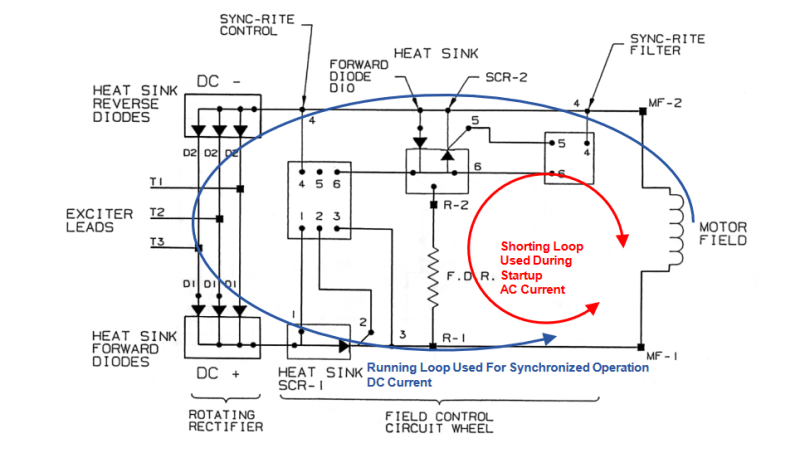All the steps:
1) Check that all the necessary "required to run" auxiliaries are powered up and doing what they should (i.e. fans moving air, pumps pumping fluid, etc.).
2) If the excitation circuit requires an external power source (e.g. the nameplate reads excitation requirements as something less than 300 V and a current below 10 amps), make sure the excitation power source is ON. This powers the exciter stator winding.
3) Close the breaker to the main stator circuit. This energizes the main stator winding at nameplate voltage, or whatever voltage the soft starter is set to produce.
4) Let the synchronous rotor spin up toward synchronous speed. This is happening because the amortisseur winding is acting like a cage on a squirrel cage induction machine, creating what is known as an inductive start.
5) The "brains" on the rotating rectifier portion of the exciter circuit will check for two things: a) sufficient voltage buildup to properly operate the silicon-controlled rectifier (SCR) which rectifies the AC power created by turning the exciter rotor (a wound rotor induction winding) inside the magnetic field of the exciter stator, and b) a low enough frequency differential between rotor and stator voltage waveforms (i.e. approximately 3-5% slip).
6) Once conditions are correct, the "brains" trigger the SCR to allow current to flow to the main synchronous rotor winding, causing the machine to "pull in" to synchronism. It should ALSO trigger another rectifier to open-circuit, taking the field discharge resistor (FDR) - if there is one - out of the circuit.
Problems on starting are usually one of the following:
A) Incorrect field current to the exciter from the exciter supply (should be set for unity power factor value).
B) Power factor relay is tripping the system out because the time delay isn't long enough to get the motor up to speed, thus the "observed" power factor is way down in the mud.
C) The load is higher than what the synchronous machine can handle - which is quite a bit lower than a squirrel cage induction, for instance. This may be a result of material left in the process from the previous stoppage or may be simply a different condition (all louvres closed, for instance, creating a higher-than-expected back pressure).
D) Damage to the rotating control wheel - most commonly, the fine wires that run from the "brains" to the SCR gate terminals.
E) Damage to the "brains" unit itself.
Important - if the signal to the SCR controlling the FDR portion of the circuit is inactive and the FDR remains in the circuit at synchronization, there is a reduced torque present (some of the energy being wasted in the FDR). This may take the machine out of synchronism almost immediately or may create a condition where synchronism is impossible to begin with.
Converting energy to motion for more than half a century

